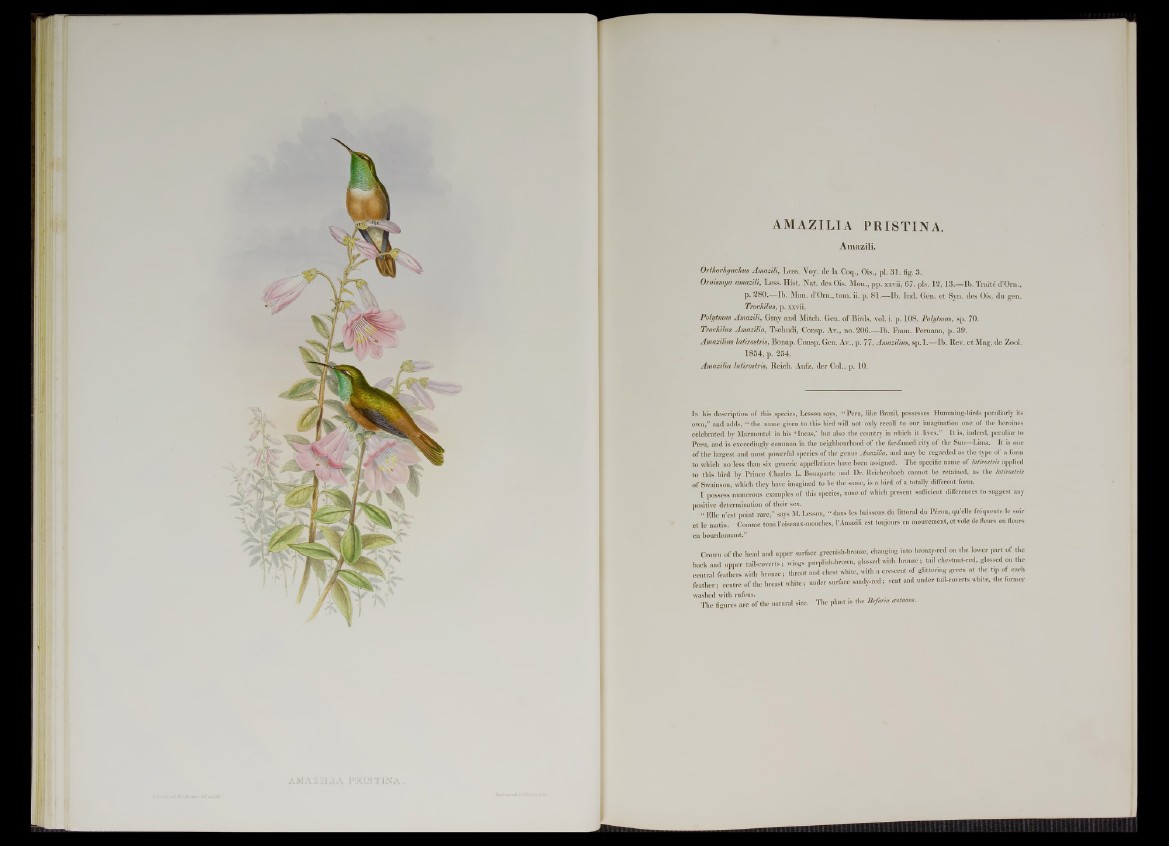
AMAZILIA PRISTINA.
Amazili.
Orthorhynchus Amazili, Less. Yoy. de la Coq., Ois., pi. 31. fig. 3.
Omwmya amazili, Less. Hist. Nat. des Ois. Mou., pp. xxvii, 67. pis. 1 2 ,1 3 .— lb . Traité d’Om.,
p. 280.— lb . Man. d’Om., tom. ii. p. 81.—lb . Ind. Gen. et Syn. des Ois. du gen.
Trochilus, p. xxvii.
Polytmus Amazili, Gray and Mitcb. Gen. of Birds, vol. i. p. 108, Polytmus, sp. 70.
Trochilus Amazilia, Tschudi, Consp. Av., no. 206.—lb . Faun. Peruana, p. 39.
Amazilius latirostris, Bonap. Consp. Gen. Av., p. 77, Amazilius, s p .l.—lb . Rev. e t Mag. de Zool.
1854, p. 254.
Amazilia latirostris, Reicb. Aufz. der Col., p. 10..
I n his description of this species, Lesson says, “ Peru, like Brazil, possesses Humming-birds peculiarly its
own,” and adds, “ the name given to this bird will not only recall to our imagination one of the heroines
celebrated by Marmontel in his ‘ Incas,’ but also the country in which it lives.” It is, indeed, peculiar to
Peru, and is exceedingly common in the neighbourhood of the far-famed city of the Sun—Lima. It is one
of the largest and most powerful species of the genus Amazilia, and may be regarded as the type of a form
to which no less than six generic appellations have been assigned. The specific name of latirostris applied
to this bird by Prince Charles L. Bonaparte and Dr. Reichenbach cannot be retained, as the latirostris
of Swainson, which they have imagined to be the same, is a bird of a totally different form.
I possess numerous examples of this species, none of which present sufficient differences to suggest any
positive determination of their sex.
“ Elle n’est point rare,” says M. Lesson, “ dans les buissons du littoral du Pérou, qu’elle fréquente le soir
et le matin. Comme tous l’oiseaux-mouches, l’Amazili est toujours en mouvement, et vole de fleurs en fleurs
en bourdonnant.”
Crown of the head and upper surface greenish-bronze, changing into bronzy-red on the lower part of the
back and upper tail-coverts ; wings purplish-brown, glossed with bronze ; tail ehestnut-red, glossed on the
central feathers with bronze ; throat and chest white, with a crescent of glittering green at the tip of each
feather ; centre of the breast white ; under surface sandy-red ; vent and under tail-coverts white, the former
washed with rufous.
The figures are of the natural size. The plant is the Brfana oestmm.